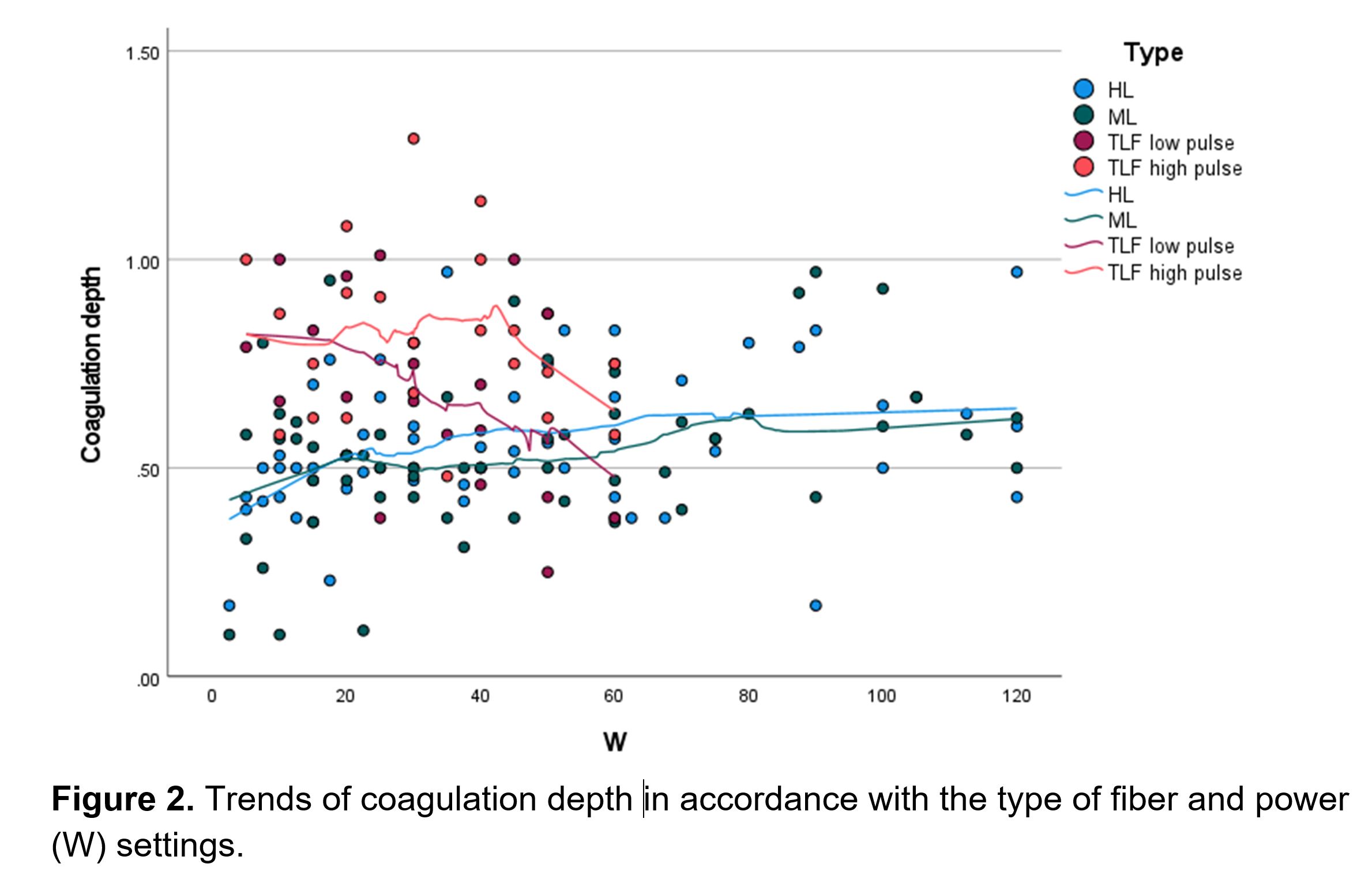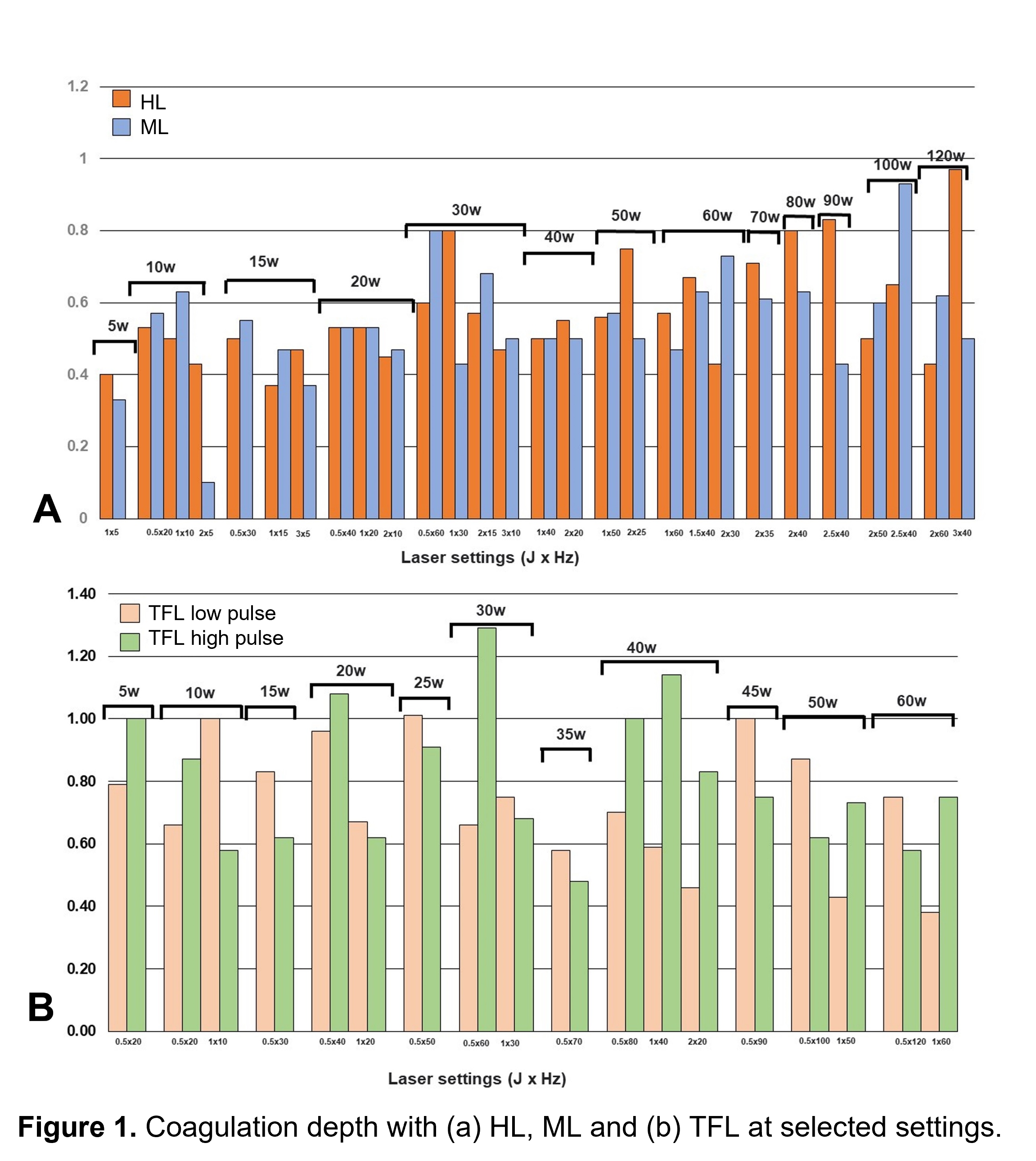Back
Poster, Podium & Video Sessions
MP04: Benign Prostatic Hyperplasia: Surgical Therapy & New Technology II
MP04-07: Ex-vivo comparison of depth of coagulation of holmium, MosesTM and Thulium fiber laser in human prostate tissue.
Friday, May 13, 2022
8:45 AM – 10:00 AM
Location: Room 228
Ruben Blachman-Braun*, Jonathan E Katz, Nicholas A Smith, Oleksii Iakymenko, Oleksandr N Kryvenko, Hemendra N Shah, Miami, FL
Poster Presenter(s)
Introduction: Understanding laser tissue interaction help in corelating clinical differences amongst outcome with various lasers. We evaluated the ex-vivo coagulation depth (CD) of holmium (HL), Moses TM (ML) and thulium fiber laser (TFL) in human prostate tissue at broad energy settings.
Methods: After IRB approval, small adenoma tissues that were removed at the end of morcellation were used. The adenoma was stabilized in bowl containing normal saline and single incision was made on its surface using a handheld 550-micron laser fiber by a single urologist. The laser fiber was cleaved with ceramic scissor and held in contact with adenoma at 450 angles to the tissue. Broad setting spectrum with variable energy, frequency and pulse duration were tested for HL, ML and TFL. Two pathologists blinded to laser settings measured CD. Each experiment was repeated 6 times and two extreme reading were excluded from statistical analysis that was performed using the SPSS v.28.
Results: A total of 163 setting with different laser energy sources were analyzed. The overall mean CD was 0.56 ± 0.53 mm for HL, 0.54 ± 0.53 mm for ML, 0.67 ± 0.67 mm for low pulse TFL and 0.81 ± 0.78 mm for high pulse TFL. The CD was similar with HL setting of < 50W and > 50W (p = 0.493). There was a trend of increase in CD with increasing power of ML and HL (HL: r = 0.398; p = 0.001, ML: r = 0.283; p = 0.031). However, variation in energy and frequency at same power setting did not result in significant difference in CD. The TFL had comparable CD to HL and ML, however with higher power settings there was a trend towards statistically insignificant reduction in CD. Variation in pulse setting of TFL did not cause any significant difference in CD (figure 1 and 2).
Conclusions: The mean CD is comparable amongst HL, ML and TFL. Increase in power of HL and ML result in increase in CD and that of TFL result in a statistically insignificant trend towards reduction in CD.
Source of Funding: None


Methods: After IRB approval, small adenoma tissues that were removed at the end of morcellation were used. The adenoma was stabilized in bowl containing normal saline and single incision was made on its surface using a handheld 550-micron laser fiber by a single urologist. The laser fiber was cleaved with ceramic scissor and held in contact with adenoma at 450 angles to the tissue. Broad setting spectrum with variable energy, frequency and pulse duration were tested for HL, ML and TFL. Two pathologists blinded to laser settings measured CD. Each experiment was repeated 6 times and two extreme reading were excluded from statistical analysis that was performed using the SPSS v.28.
Results: A total of 163 setting with different laser energy sources were analyzed. The overall mean CD was 0.56 ± 0.53 mm for HL, 0.54 ± 0.53 mm for ML, 0.67 ± 0.67 mm for low pulse TFL and 0.81 ± 0.78 mm for high pulse TFL. The CD was similar with HL setting of < 50W and > 50W (p = 0.493). There was a trend of increase in CD with increasing power of ML and HL (HL: r = 0.398; p = 0.001, ML: r = 0.283; p = 0.031). However, variation in energy and frequency at same power setting did not result in significant difference in CD. The TFL had comparable CD to HL and ML, however with higher power settings there was a trend towards statistically insignificant reduction in CD. Variation in pulse setting of TFL did not cause any significant difference in CD (figure 1 and 2).
Conclusions: The mean CD is comparable amongst HL, ML and TFL. Increase in power of HL and ML result in increase in CD and that of TFL result in a statistically insignificant trend towards reduction in CD.
Source of Funding: None


.jpg)
.jpg)
